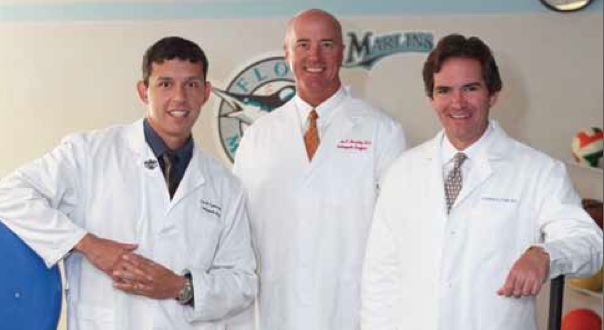Zephyrs’ Orthopedist Keeps Players in Top Form
When people in New Orleans think sports, they tend to think football first and basketball second. But New Orleans is a baseball town, too. The Zephyrs, the minor league team that plays in its own stadium on Airline Drive in Jefferson Parish, laid its roots in New Orleans almost 20 years ago. The players on the team work as hard as any other New Orleans athletes, and orthopedist Luis Espinoza, M.D., makes sure they stay in top form.

“I work closely with the head athletic trainer,” Espinoza says. “When there’s an injury, he’ll call me. I either see the players at Zephyr Field itself, or I’ll treat them in my clinic, which is right nearby.”
Espinoza says that with 142 games over a grueling five-month season, the athletes can suffer from a lot of overuse injuries. All players, and pitchers especially, make countless throws each week, creating repetitive stress that can wear down tissue and lead to inflammation.
“I see many tendinitis issues and sore throwing shoulders and elbows,” he says. “Players can end up getting rotator cuff tears. All baseball players face similar injuries whether they’re in the major league, the minor leagues or the little leagues. The important thing is to identify the injuries and address them early.”
Also, baseball players typically develop a dominant side and a non-dominant side. To keep the skeletal structure of the body well-balanced, players need to do a particular strength and conditioning program that corrects the unevenness. Also, in sweltering New Orleans summers, heat is always a factor, and players need to take care to stay hydrated.
In his practice, which is called the Orthopedic Center for Sports Medicine, Espinoza has two physician partners, as well as a team of physical therapists and assistants. The practice has X-ray and MRI capabilities in-house, but for surgeries, the doctors use Omega Hospital in Metairie.
“With Omega, we have been able to serve athletes in a smaller hospital setting. It’s more intimate in that it has a limited number of beds and a low nurse-to-patient ratio,” Espinoza says. “The whole premise of Omega is to deliver a high level of care in a comfortable setting, more like something you would see in a hotel instead of a large, sterile hospital.”
Espinoza and his partners rarely operate on Zephyrs players at that hospital, however. For one, the players don’t often need surgery, but when they do, they tend to have operations done in Miami because the team is an affiliate of the Florida Marlins. In actuality, only 5 percent to 10 percent of the orthopedic center’s practice is related to the Zephyrs team. The rest of the client mix comes from ordinary people in the community.
“We see everyone from high school and college athletes to grandmothers who might need treatment for falls, tendinitis or arthritis issues,” he says. “For my practice partners and I, our aim is to be accessible and have flexible schedules. Our approach is about service, service and service. When you’re sick and hurting, the last thing you want is to be bounced around and not know where you are in the whole treatment process.”
Like other doctors in the field of sports medicine, Espinoza is a big sports fan. He loves the Saints, the Hornets and, of course, the Zephyrs. As a child, his family moved around a lot, and he landed in Louisiana for medical school at Louisiana State University. But Espinoza says he really first got into baseball when he landed a competitive sports medicine fellowship at the University of California in San Diego. His directors and colleagues there were big fans of the San Diego Padres, and everyone would go to their games together. Espinoza was hooked.
He didn’t always know his love of sports would lead him into a medical career, but he did have his eyes on becoming a doctor since high school, when he found he excelled in his science classes. Besides, it didn’t hurt that both his parents were doctors. His father still works as a rheumatologist and his mother just retired from a career in pathology. Espinoza’s younger sister went to medical school, too, and through her, Espinoza met his wife, Andrea, who is also a doctor (a pulmonologist to be exact).
At one point, Espinoza was considering specializing in pediatrics, and it wasn’t until his third year of medical school that he settled on orthopedics, and on sports medicine in particular. “I liked how I could have both adults and kids as patients, and I liked the minimally invasive nature of the surgeries,” he says. “With sports medicine, you can deal with a broad range of orthopedics and aren’t limited to specific parts of the body like the back or the hand.”
Meanwhile, the field of sports medicine keeps evolving with implants and surgical techniques improving all the time and new oral and injectable medicines constantly being brought to market. Furthermore, the Internet has facilitated sharing between doctors.
“Peer-review websites have helped doctors in sports medicine cut down on errors and develop gold standards,” he says. “We’re coming together around treatments that have been proven to work.”
-Henry Alpert
